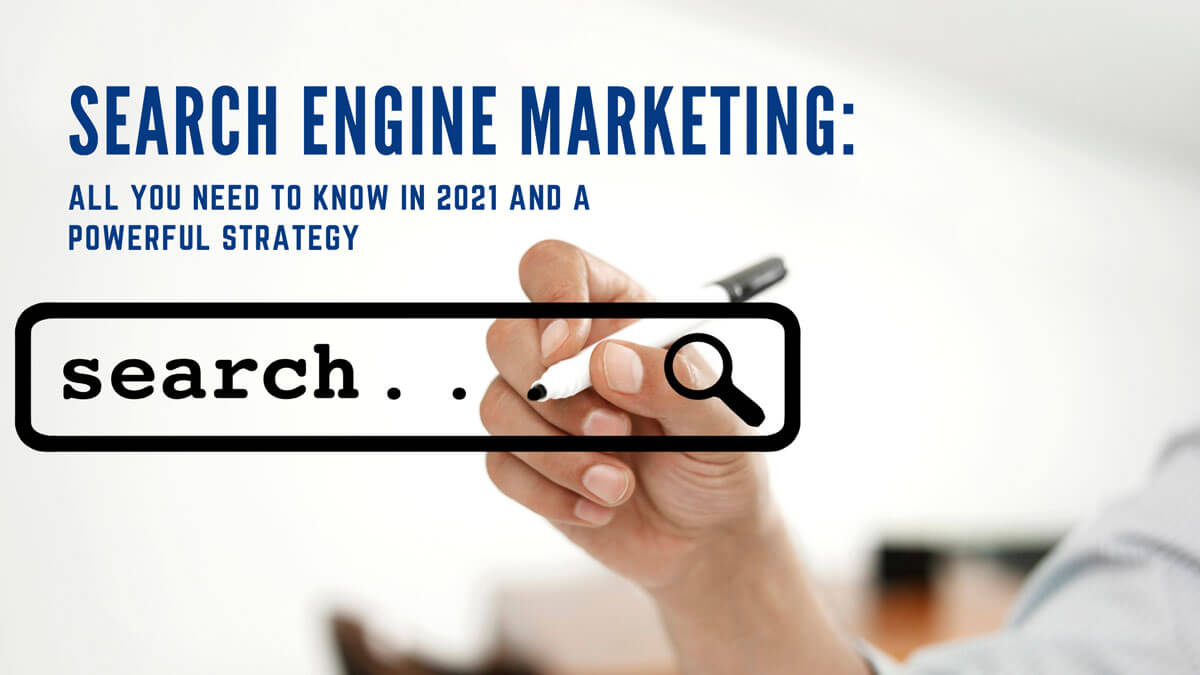Introduction – Search Engine Marketing: All You Need To Know In 2021 And A Powerful Strategy
What is Search Engine Marketing? Search Engine Marketing (SEM) is the process of getting your website ranked higher on search engine results pages so that it appears before other websites in searches for a particular topic. Search engines use algorithms to rank web pages according to their relevancy and popularity—two factors that are hugely influential when people want to find information online.
Search engine marketing is a form of online advertising that helps you get your business found and seen by more people on the Internet.
SEM can be used for many different purposes, such as increasing brand awareness or driving conversions.
Now we might be asked how can Search Engine Marketing grow your business online?
Why is search Engine Marketing important and what can you do to improve your SEM results?
Don’t worry.
In this blog post, we will be answering all these questions and more so our readers will know all there is to know about Search Engine Marketing.
It will be a complete guide to Search Engine Marketing, so let’s jump right in!
Download Our Free eBook
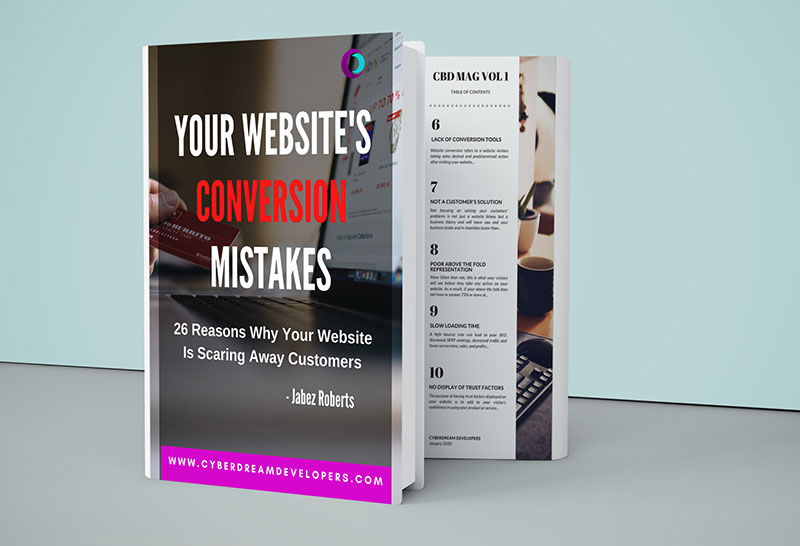
What Is Search Engine Marketing?
Search Engine Marketing is an important part of a company’s online marketing strategy.
Search Engine Marketing (SEM) is the process of getting your website ranked higher on search engine results pages so that it appears before other websites in searches for a particular topic.
Search engines use algorithms to rank web pages according to their relevancy and popularity—two factors that are hugely influential when people want to find information online.
It is also a valuable marketing strategy that many businesses are using to grow their business.
Search Engine Marketing is the art and science of influencing the visibility of one’s website or brand in search results pages, especially on Google Search.
Search Engine Marketing encompasses both pay-per-click advertising (PPC) like Adwords and organic SEO which helps your website rank higher for certain keywords that you would like to be found for on Google Search.
Search Engine Marketing can be done through both Search Engine Optimization and Pay Per Click advertising.
Search engine optimization involves improving the website’s rankings in search engines by following certain SEO techniques, while pay-per-click advertising allows you to purchase ads on search engines like Google and Bing.
What Are The Benefits Of Search Engine Marketing?
There are many benefits of doing Search Engine Marketing in your business.
Some of the advantages include:
Increase Brand Recognition
Google’s Search Ads are a way for advertisers to get their brand name on ads that often show at the top of search results.
It provides high-level visibility and immediate trust when consumers search for products or services, which in turn leads to increased exposure.
This happens because Google Ads allows you to share your company name, website URL, and a custom headline and text at the top of the Search Engine Result Pages (SERPs).
This will cause most of the website users who get to this SERP to become aware of your business.
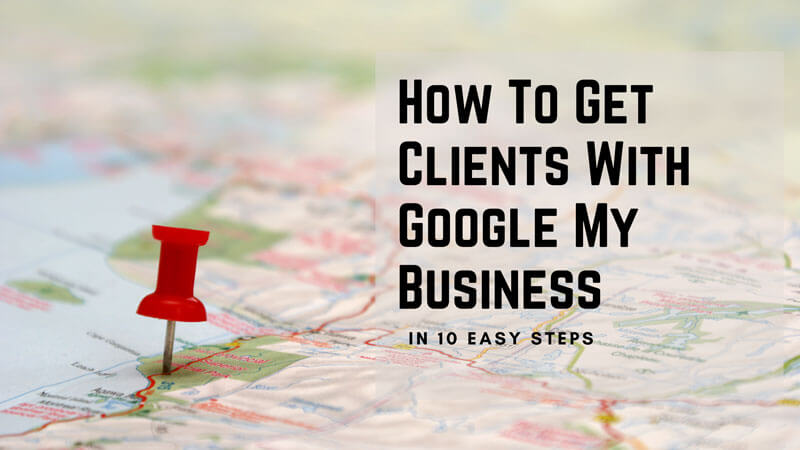
Increase Search Traffic
Search engine optimization (SEO) is the process of affecting the visibility of a website or web page in a search engine’s unpaid results—often referred to as “natural,” “organic,” or “earned” results.
These are not ads; these are listings that rank on their own merit and reflect what current, active web pages visited by an actual person would look like if they were submitted into Google Search Engine for indexing.
This means you can get your products seen without paying anything!
SEM helps increase traffic to websites and blogs using organic searches so it increases brand recognition and customer acquisition at no cost!
Increase Local Visibility and In-store Visits With Geo-Targeted Search Ads
A Geo-targeted search ad is an ad that is targeted to a specific geographic area.
Search engines allow you to have your ads show up for people who are in the vicinity of where you would like them seen and these ads will only be shown if someone searches for an item or service near your location.
With Search Engine Marketing, businesses can now reach their target audience by geography which saves time from having users travel all over town looking for what they need!
Create Ads With Keywords
Using Search Engine Marketing enables business owners to conduct keyword research about keywords related to their products or services.
This helps them to know which words are most likely to provide traffic when used as search phrases on Google Search Engine, Yahoo Search Engine & Bing Search engine.
It’s important to use keywords because it helps ensure that any potential customer will be able to find you organically with Inbound Marketing.
Instantly Start Generating Leads And Sales
Search Engine Marketing can be used to bring traffic, leads, sales, and customers to your business seemingly overnight.
By using Google Ads, Keyword Research, and Geo-Targeting you will be able to target your ideal customer wherever they are by appearing at the top of relevant searches with the right keywords.
This will allow you to start generating leads, customers, and sales for your business.
Suggested article: How To Get Clients With Google My Business In 10 Easy Steps

Increase Website Traffic
One other way that Search Engine Marketing can positively influence your business is by helping you to get more traffic to your website.
By using SEM you can set up ads that will generate as much traffic as you’re willing to pay for to your website.
This is an inorganic means of driving traffic to your website and while it certainly has its benefits it also has its downsides.
To learn more about organic and inorganic traffic we have prepared a detailed website traffic guide for you. You can access that guide here: Website Traffic Guide: How To Convert Cold, Warm, And Hot Traffic
Pay Only When You Make A Sale
One of the biggest advantages of Pay Per Click campaigns and Search Engine Marketing is the fact that you can set up ads that only bill you when your prospect takes a desired action like clicking on a link to your website.
By doing this you will be better able to stay on top of your budget and get the best results possible by tweaking and split testing your ads until you have the best performing ad with the most efficient metrics.
Appear In Searches For Your Competitors
One of the best ways to utilize Search Engine Marketing is by using Google Ads to compete with keywords related to your competitors.
We were once in negotiations with a client that needed a complete online presence (website and social media) for their business. When we searched the business’s name we found out that their competitors were displaying Google Ads to customers who were searching for them.
Can you imagine the revenues they’ve lost to that competitor?!
This is one way that using Google Ads and SEM can help you to get the edge over your competitors.
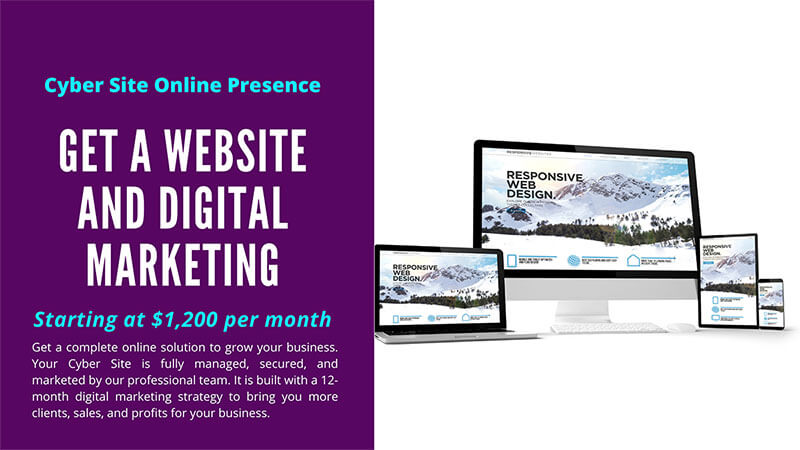
What Is The Difference Between SEO and SEM?
We have been hearing the words “Search Engine Marketing,” “Search Engine Optimization,” “Organic Traffic,” and “Keywords” thrown around for a while now but what do they actually mean?
Let us explore.
Search Engine Marketing – SEM
As we discussed before Search Engine Marketing is the process of attracting visitors to your website via organic and paid search results.
Search Engine Marketing (SEM) is a way for businesses to grow their audience online by using keywords in order to rank higher on search engines like Google, Bing, Yahoo!, etc.
Search Engine Marketing also includes strategies such as Search Engine Optimization (SEO) and Pay-Per-Click or PPC advertising.
Search Engine Optimization – SEO
Search Engine Optimization is the process of optimizing your website to rank higher in Search Engine Results Pages.
Search engine optimization is so important because it can help you increase organic traffic and sales leads from search engines, such as Google or Bing.
Search Engine Optimization also includes strategies like backlinking – the act of posting links on other sites pointing at pages on your site – which increases page ranking for those specific pages.
There are many different important activities to improve your SEO results and performance such as On-Page SEO, Off-Page SEO, Backlinks, and Technical SEO.
We will provide a helpful video below to teach you more about SEO.
What Is the Difference between Organic and Inorganic traffic?
As we continue to learn more about Search Engine Marketing and Search Engine Optimization we have continually made reference to the terms organic traffic and inorganic traffic.
But what are they and how do they relate to SEO, SEM, and your online success?
Let us learn more below.
Organic Traffic
Organic traffic is traffic generated through organic means like Search Engine Optimization that happens naturally as a user searches for products and services related to your keywords.
It is also the keyword that a web page appears for in organic search results on Google or another search engine.
Organic Traffic is any type of website visitors which are driven by natural, non-paid (organic) search results on search engines such as Google. When people click those links and visit companies’ websites those clicks become visitors to their sites!
This type of traffic can be free and doesn’t rely on ads being clicked for profit generation as paid search ads do.
Organic traffic usually accounts for up to 80% of all site visitors coming from Search Engines – meaning it’s an important factor when trying to rank well in Search Engine Results Pages!
Inorganic Traffic
Inorganic traffic is any type of website visitors which are driven by paid Search Results on Search Engines such as Google.
In other words, these types of visits come from clicking ads and visiting websites when they appear in the top or right sidebars in SERPs (Search Engine Result Pages).
These clicks usually generate profit for companies who participate with SEM advertising because those advertisers pay to be featured at the top or sidebars of Search Engine pages!
Paid Search Ads typically make up 20% – 50% of all site visitors coming from Search Engines depending on the business niche it’s targeting.
We have prepared a detailed guide on organic and inorganic traffic to help you decide which is best for you.
The guide will also help you with different strategies to grow your business online using organic and inorganic traffic.

How To Understand Keyword Research For SEO And SEM
Keyword research is important in Search Engine Marketing.
Keyword research is the process of searching for highly relevant search terms that your target audience or ideal customer will use in a search engine like Google or Bing.
Search engines try to find the most relevant keywords that will help people get what they want from their search engine.
Keywords can be found in many different ways.
You can use tools like Ahrefs Keyword Explorer, Semrush, and Keywords Everywhere to find relevant and highly searched keywords that your target customer is searching for.
Our favorite tool to use for keyword research for our business is Ahrefs’ Keyword planner tool.
But you don’t have to get a premium, paid tool to find helpful keywords for your SEM campaign.
In fact, Google Ads has a built-in Keyword tool that will help you to learn valuable keyword metrics that you can use for your SEM campaign like Google Ads Pay Per Click Campaigns.
Another way that you can find relevant keywords for your blog topics and other organic traffic campaigns is by using the autocomplete feature in Google.
The autocomplete feature will tell you what is similar and popular searches that relate to the search term you enter into your search bar.
The autocomplete is one quick and easy way to find topics to blog about and make YouTube videos for organic traffic generation but it’s a poor choice for getting keywords to run PPC ads with on Google.
You can also use words that you think would work well for your business as potential keywords, but keep in mind not all of these may be worth it if there is little to no traffic on them.
For this reason, it might be safest to use a premium tool that gives you all the latest metrics on search volume and ranking difficulty for each search term.
We have prepared a video for you to help you learn more about Keyword and Keyword research below:
How To Grow Your Business With SEM
You might be wondering how to grow your business online with Search Engine Marketing.
As you know, Search Engines like Google search for keywords that are highly relevant to what your target customer wants to find.
SEM campaigns use these keywords and target them with ads in places where they can be found at the top or sidebars of the page such as Facebook Ads Manager and Adwords Campaigns (Google Ads).
These ads usually contain a form that asks for an email address so that they can contact customers when there’s a new offer on their product or even go directly for a sale.
Most companies and marketers, however, make the mistake of running ads on Google or Facebook and sending the traffic directly to their website’s home page.
This is the worst mistake you could ever make and it will destroy your conversion rates and hike your Cost Per Lead (CPL).
Many companies invest heavily in these types of campaigns.
In fact, many companies have paid up to $5 per click just online from these types of advertisements but this type of advertising may not be right for every company.
You need patience and money if you want to see a return when investing in paid advertisement for your business.
Instead, you can go for organic ways of getting traffic to your website. You can learn more about organic and inorganic traffic by reading this guide:
There are many ways that you can grow your business online with search engine marketing.
Search Marketing is a fast, effective way to grow your business by targeting potential customers with the content and keywords for which they are searching.
Search engine marketing (SEM) is when you advertise on search engines like Google and Bing in order to promote your website or company brand online.
Some of the ways that SEM can grow your business have been outlined above in the section on the benefits of search engine marketing.
If you have not read that section please scroll up and take a look at it.
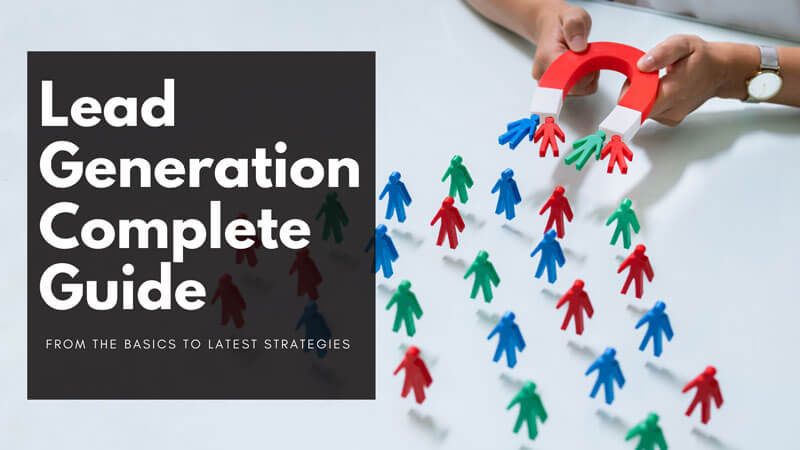
Below we will list some of the additional ways that SEM can benefit and grow your business online.
Search Engine Optimization
SEO techniques including using keywords correctly, title tags, meta descriptions, and site map listings will help increase the visibility of your blog post or a web page in organic searches.
This will increase your traffic, leads, and the amount of money you make from your website.
Search Engine Advertising
Search Engine Advertising techniques including keyword research, banner ads on search engines, sponsored links, and pay-per-click will help you reach out to more visitors and give you a rapid boost in website visits, lead signup, and sales.
This is especially helpful if you have a large marketing budget and you’re looking for immediate results.
Social Media Marketing
Build an audience around your blog post by using social media platforms like Twitter or Facebook for instance. This will increase the visibility of your content because it’ll be shared with others who may not have seen it otherwise.
The best part?
You can do this without spending any money! (Phew!)
Recommended articles:
- Use Social Media To Market Your Business These 15 Awesome Ways
- How To Choose The Best Social Media Platform To Market Your Business In 2021
Email Marketing Campaigns
Have people sign up to receive emails from you in order to stay updated on what’s happening in their industry.
It might sound old fashion but email is still one of the most powerful online marketing tools available today.
Email marketing is especially helpful in building a relationship with your leads and prospects. This will eventually result in a conversion from a prospect to a customer or client.
Link Building Strategies
Link building is a technique used to improve the Search Engine Optimization of your website.
One way is by getting backlinks from other websites or blogs that have a good Search Engine Ranking. This will increase your Search Traffic and make it easier for people to find you online, eventually leading to increased sales or leads, and can help increase rankings and visibility in search engine results pages (SERPs).
Essentially, this strategy involves getting links from other sites pointing at yours.
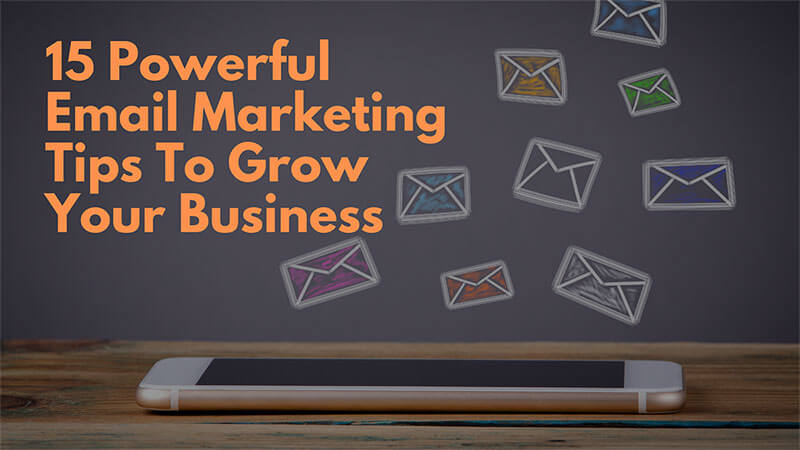
In summary, by taking advantage of these you will experience an increase in your website traffic, online visibility, lead sign-ups, and a constant influx of new customers, sales, and clients.
We have prepared an SEM strategy below for businesses of all sizes, whether small, startup, or large enterprise, and industry, whether e-commerce, B2B, or B2C, that you can use today to start growing your business online.
Keep reading to find that strategy.
Strategies To Be Successful At SEM
We know you want to grow your business online and be successful at SEM but you don’t know where to start.
So, we are going to give you a few tips to help you get started and be successful at SEM in your business.
Alternatively, if you think this is too much work you can set up a free consultation with our team and we will help do all the heavy lifting involved in growing your business online.
Set up your free consultation with us here.
Now, let us tell you some things you need to do and ensure are in place to be successful at Search Engine Marketing:
To get started with Search Engine Marketing (SEM), you need to have a conversion-optimized website with an active blog.
Then you need to ensure the website and blog posts are optimized for search engines by using the right keywords, title tags, meta descriptions, and site map listings.
Once that’s complete create a Google Ads account in order to run paid ads on Google.
Then you will need to make use of social media platforms like Twitter, LinkedIn, and Facebook in order to build an audience around your blog post and share it with others who may not have seen it otherwise.
After you get all this done you will have all the necessary components to be successful at SEM in your business.
How Quality Score Affects Your Search Engine Marketing Success
Google Ads Quality Score is a rating system that Google assigns to your ads based on relevancy, ad relevance, and ad relevance to the keyword you’re bidding on.
The higher the Quality Score, the less expensive your ads will be, so it’s important that you monitor and improve your Quality Score.
There are a couple of different things you can do to improve your Google Ads Quality Score.
For example, one way is to track and monitor your website analytics. Make sure you’re testing keywords, ad copy, landing pages, and more to get the maximum return on investment.
Another way is to create a positive brand by including testimonials and other forms of social media engagement in your ads.
In Google Ads, a quality score is assigned to every ad based on a number of factors.
The higher your quality score, the better your Search Engine Marketing campaign will perform!
A high-quality SEM campaign with good keywords and ads can increase clicks by as much as 50% more than an average or low-quality one.
Your Quality Score is the foundation to Search Quality and can help determine your success as it is the most important metric for your Google Pay Per Click campaign.
Your quality score is a measure of how relevant your keywords and landing page are to the search query. The higher the quality score, the more likely it is that Google will show your ad for a given Search term.
Google calculates Quality Score by looking at three factors:
- How well you’ve targeted Search terms with ads and keywords
- Clickthrough rate of those Search terms (the number of times people clicked on an ad divided by total impressions)
- Relevance between keyword or topic as related to what was searched – which can be determined through words from search queries used in conjunction with keywords found within content published on your site.
The better these scores, then generally speaking Google would rank you higher than lower-scoring competitors when a relevant search term with your keywords is made.
A higher quality score will also reduce your ad costs by generating a higher CTR and lowering your cost per click.
This will result in more conversions for a lower cost.
We have prepared a detailed article on ways to improve your Google Ads Quality Score. You can read that article here:
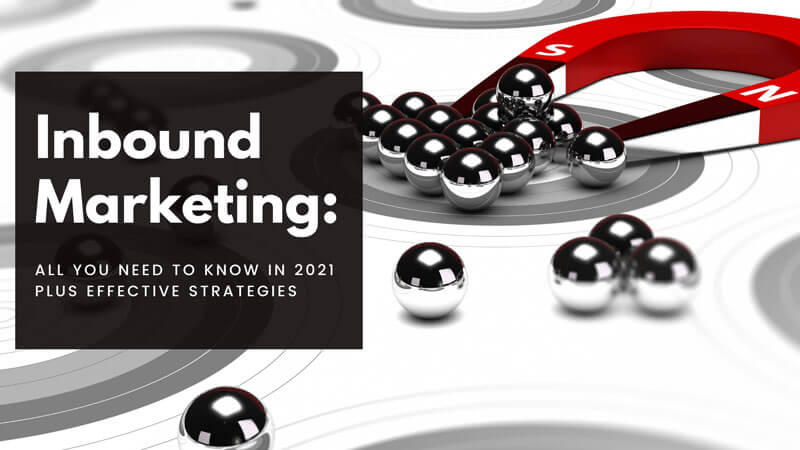
One SEM Strategy For Success
In this section, we are going to give you one powerful and effective Search Engine Marketing strategy to help you find success online in your business.
The strategy will be broken down into several smaller, more easily executable steps that you can follow no matter where you are in your marketing process, the size of your business, or the industry you work in.
The beauty of this strategy is that it is built to generate leads and long-term success using SEM.
In other words, you might be spending a bit of cash to invest in marketing your product or service using Pay Per Click ads but the conversion we will be going for is a soft conversion, not a hard one.
The preferred soft conversion is a simple email list subscription. We will build our entire marketing strategy around the power of email marketing to drive conversions, traffic, and build loyalty among fans and customers.
You can learn more about hard and soft conversions in digital marketing by reading this guide that we have prepared for you: Hard Conversions And Soft Conversions Explained: 10 Powerful Tips To Get More Conversions
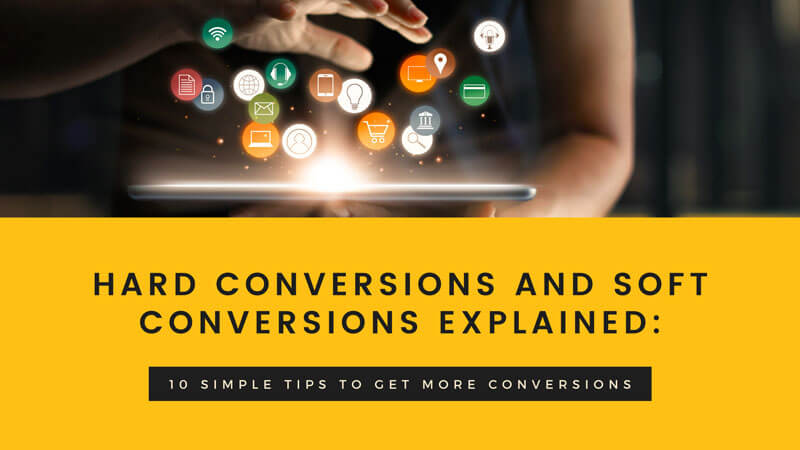
Step 1: Set SMART Marketing Goals
In digital marketing, a SMART Goal is a goal that is Specific, Measurable, Attainable (do-able), Relevant and Timely.
Smart Goals help you to keep on track with your business and marketing goals, set better business and marketing goals, and increase the possibility that you’re successful.
SMART Goals will improve your marketing campaigns by providing you with a specific target to aim for. For Search Engine Marketing, SMART Goals might include:
- Generate 50 new leads in the next three months
- Increase our website visitors by 20% this year over last year
- Double the number of Facebook fans we have by March 31st, 2022
It’s important that your goals are achievable. If you make goals that seem out of reach, it’s going to discourage you and prevent you from moving forward with Search Engine Marketing
To help you with learning how to set better SMART Goals we have prepared a detailed guide that will teach you everything you need to learn about SMART Goals.
It will also give you 5 powerful and effective strategies to set better SMART Goals and use them in your life and business.
Learn more about setting better SMART Goals here: Set Better SMART Goals With These 7 Strategies

Step 2: Find Your Keywords
We have discussed the importance of keyword research to SEO and SEM above. We have learned what keyword research is and how important it is for us to get it right.
We have also taken a look at some ways to do keyword research for our marketing campaign whether it be for content creation or for paid advertising campaigns on Google.
In this step, we must do keyword research for a PPC campaign on Google Ads.
There are many ways that you can use Google Ads to grow your business. You can use Google Ads to get more clients and sales overnight but we will not try to get a hard conversion like that.
Instead, we will go for a soft conversion that is easy to get and effective in growing our business in the long term. We will aim for an email subscription.
The way we will do this is by offering something for free that is of incredible value to our website visitors. Some of the things we can offer for free include:
- A free book
- A coupon or discount code
- A free trial
- A product sample
- A free consultation
- An eBook
- Access to a webinar
- Access to a lesson from our online course
The idea is that what we offer must be something of extremely high value to our prospects in return for their email address.
It must be something that educates them about their problems and helps them to solve them. It must move them away from the pain their troubles are causing them and towards the pleasure a solution brings.
It must be highly relevant and highly helpful.
To learn more about increasing your email signups we will link to some free resources below:
- Is Email Marketing Dead In 2021?
- Email Marketing to Grow Your Business: 15 Powerful Conversion Tips
- 40 Genius Ways To Increase Your Email Signups
- 32 Powerful Website Traffic Generation Techniques You Need To Try
- 12 Powerful Email Marketing Strategies Your Small Business Need To Succeed In 2021
- 14 Types of Email Marketing Campaigns for Small Businesses: How to Increase Revenues!
Step 3: Create A Dedicated Landing Page
A dedicated landing page is the best way to capture new leads for your business.
With a dedicated landing page, you can ensure that people are converting to what you need them to convert to (ie. email signups).
Not only does this provide an easy way of keeping track of your marketing campaign but it also improves conversion rates.
One of the biggest conversion mistakes we see businesses and other marketers do is not using a dedicated landing page for every ad they run.
When you set up a Google Ads or any other paid advertisement you have to ensure that the landing page is set up to speak directly to your cold traffic, warm traffic, and hot traffic.
You speak to each type of traffic differently and if you try to speak to all of them in one sentence or landing page you will end up speaking to none of them.
You can learn more about this by reading this guide we’ve prepared for you on the differences between cold, warm, and hot traffic.
We recommend you create a dedicated landing page for all your campaigns, all your audiences, and all your offers.
By doing this you will have the highest chance of converting your prospects to leads.
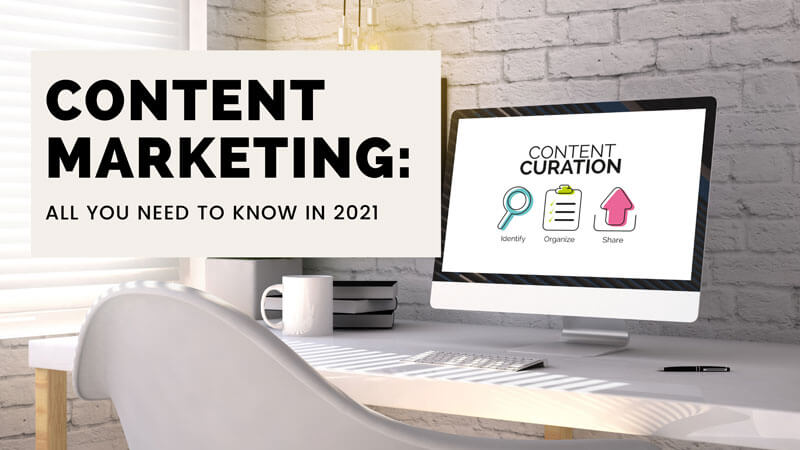
Step 4: Create Organic Content
In this step, you will create organic content to organically attract website visitors through Search Engine Optimization.
The content you create to generate organic traffic should be helpful to your prospects in solving their problems.
We recommend that you use Inbound Marketing and Content Marketing to create this content.
Inbound Marketing and Content Marketing is the best way to create content that is useful and educational.
Inbound Marketing is a strategy that focuses on providing quality content for the target audience to draw them into your website.
The meat of Inbound Marketing comes from using tools like blogging, podcasting, and YouTube.
The goal of Inbound Marketing is to become an expert in the eyes of your target audience by focusing their attention on you.
You do this by answering questions they have and giving them valuable advice for free. This allows them to slowly see you as a trusted advisor and builds their confidence in purchasing products or services from you.
Inbound Marketing is not marketing at all, it’s about being helpful to people who are trying to solve their problems and then letting these people choose whether or not they want to buy anything from you.
You can learn more about Inbound Marketing by reading this blog post we’ve written called: Inbound Marketing: All You Need To Know 2021 Plus Effective Strategies
It is a detailed guide that will teach you all you need to know about Inbound Marketing and even give you a highly effective inbound marketing strategy that you can use in your business today. You can find that guide here:
Content marketing is when you create free content to distribute on the internet. This usually takes the form of videos, blog posts, infographics, or podcasts.
The goal of Content Marketing is to provide your prospects with high-quality information about a specific topic that they are searching for online and then converting them into leads.
To learn more about how you can use Content Marketing, check out this blog post we’ve written called: Content Marketing: All You Need To Know In 2021
It has a lot of great advice on ways you can use Content Marketing for your Search Engine Optimization campaign.
In it, we talk about some awesome benefits such as generating high-quality website visitors from organic search results which will then convert into leads.
We also talked about the importance of creating SEO-friendly content with keywords for our prospects’ problem areas in order to rank higher on Google SERPs (Search Engine Results Pages).
Both your organic content and your Pay Per Click advertisements should have links that direct traffic to your landing pages.
Now we will take a look at what you need to offer on your landing page to get the best conversion rates.
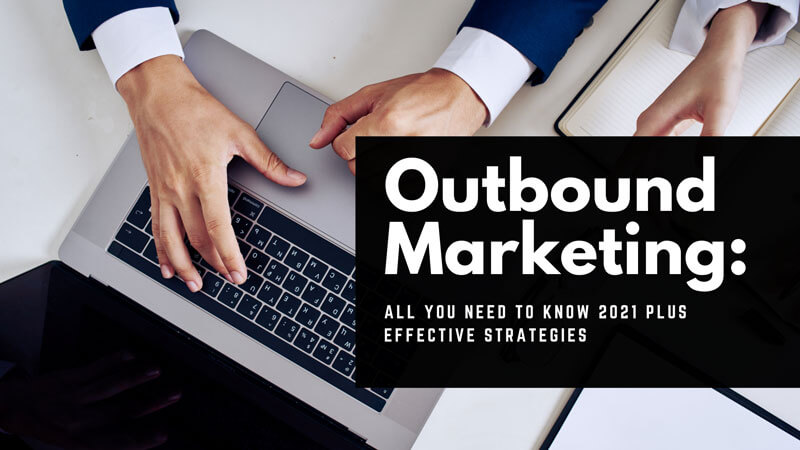
Step 5: Landing Page Conversions – The Soft Conversion
In this Search Engine Marketing strategy to instantly start growing your business online, we will get you the best conversion rates possible from your landing page by going for a soft conversion, not a hard one.
What is the difference between a soft conversion and a hard conversion?
In digital marketing, a soft conversion is when someone visits your landing page and they convert by signing up for a free trial or becoming an email subscriber. A hard conversion is when someone purchases something from you after visiting your website or reading an offer on your blog post.
We have prepared a detailed guide on soft vs hard conversion in digital marketing. You can find that guide here
The soft conversion that we will aim for is an email subscription. We will use the power of email marketing to improve your landing page conversion rates.
Email Marketing is one of the most effective ways to grow your business online, even in 2021.
The power of email marketing comes from using autoresponders, drip campaigns, welcome emails, and nurture campaigns (personalized emails sent over time) to woo prospective customers into becoming paying customers.
The best part about it?
You can set up an autoresponder sequence for a few dollars per month that will automatically get sent out when someone signs up for your email list or when someone buys something off of your website.
The offer on this page should be geared towards making the soft conversion, not getting a client or customer there and then.
That means we will offer them something of extremely high value in return for their email addresses.
We will teach you all the different free offers you can use to get an email subscription as well as how to convert more of your landing page visitors to email subscribers in the resources section at the end of this step.
When you use this strategy, all you need to do is create content for each email – no more writing individual messages!
This way you can focus on creating as much great content as possible so that people are buying from you over and over again.
You will also have a powerful tool for building a relationship with your clients and prospects.
This relationship can help to create a loyal client or fan that will support your brand for a lifetime.
To learn more about the power of email marketing, how to improve your email marketing signups, get more clients and grow your business online we will provide a list of free email marketing resources below:
- 12 Powerful Email Marketing Strategies Your Small Business Need To Succeed In 2021
- How To Supercharge Your Inbound Marketing Results With Email Marketing
- 40 Genius Ways To Increase Your Email Signups
- 14 Types of Email Marketing Campaigns for Small Businesses: How to Increase Revenues!
- 16 Powerful Email Marketing Lead Generation Strategies
- 1 Powerful Digital Marketing Strategy for Small Businesses and Startups

Step 6: How To Get The Sale Or New Client
In this step, we are going to teach you how to get a new customer or client from your email subscriber.
The way to do this is to use the power of email marketing to build a relationship with your prospect.
Without trust, your prospect will never buy from you. Instead of losing a prospect with a hard conversion on our landing page, we have gained a lead or prospect by going for a soft conversion and offering something of high value in return for this soft conversion.
From this point, we will use a welcome email drip sequence to instantly convert our warmest and most eager leads into customers and clients.
The welcome email drip sequence will also be used to immediately start building a deeper relationship with our leads.
As we build a relationship with our leads we will also be helping them learn more about their problems and possible solutions to their problems.
By doing this we will be strengthening our bond with them, increasing trust, positioning ourselves as an expert and authoritative voice, and also keeping ourselves and our business top of mind.
Being top of mind means that our leads will think of us when they need to buy something and then come back and buy from us instead of buying from the first company that pops up in their search engine.
We can also use nurture campaigns to build a deeper, more meaningful, and emotional relationship with our prospects.
You can learn more about drip campaigns and nurture campaigns by using the resources below.
You will also get 9 email templates that you can take and use in your business today to get the best results. You can access those free resources to learn more here: 3 Effective Sign-up Drip Campaigns for Effective Email Marketing Conversions
Step 7: What To Do After The Sale
After you have received the sale or the new client there are generally two things that you need to do.
The first is that you need to try selling something else to your new customer or new client.
The reason you do this is that different people have different propensities to spend. In other words, they have a different degree of likelihood to keep spending.
This may be motivated by a deep desire to solve the burning problem they have. It’s an emotional hitch that they have finally been able to soothe with your solution and so they will do all they can to solve it.
With prospects like this, you should try to get them help as fast as possible and as much as possible.
That might include selling them complementary products and services.
The other reason is that there is no one easier to sell to than someone you just sold to.
They already know you, love you, and trust you enough to do business with you and hand over their hard-earned cash. It is highly likely that they will continue to buy from you and it’s far easier to sell to them than to sell to someone new.
This might seem really difficult to do without upsetting your lead but don’t worry.
We’ve broken it down in this blog post we’ve written that will even teach you to increase the number of revenues you earn per lead exponentially.
Learn how to do this step by reading this blog post: 1 Powerful Digital Marketing Strategy for Small Businesses and Startups
The second thing that you need to do after making the sale is to continue building a relationship with your email subscriber.
You should continue to offer massive value to them and help them learn more about their problems
You should ensure that you continue to help them and offer value because the aim of doing business, the aim of email marketing, and the aim of your campaign should be to build lasting relationships.
This relationship goes on long after you’ve made the sale.
You can also send a simple ‘Thank You’ email sequence to your prospects.
This Thank You email will help to generate trust and confidence and build your brand and public image as well.
Learn more about the Thank You email and other email sequences you should be using in your business here: 14 Types of Email Marketing Campaigns for Small Businesses: How to Increase Revenues!
Conclusion – Search Engine Marketing: All You Need To Know In 2021 And A Powerful Strategy
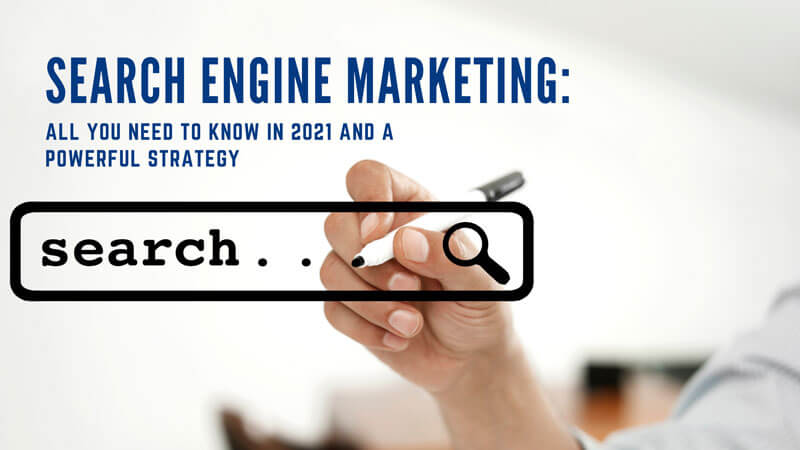
In this article, we have done a deep-dive approach to the topic of Search Engine Marketing.
Search Engine Marketing is a fantastic strategy that any company can use to grow their business online.
Search Engine Marketing is a technique that mixes creativity and science in order to create content, advertising campaigns, or anything else you want people to find on the internet when they search for your product or service.
The goal of Search Engine Marketing should be to build traffic and leads so you can build a relationship with your leads, convert them to sales and clients, and have a loyal fan for life.
If you have found this post helpful and would like help implementing a powerful Search Engine Marketing Campain into your business then set up a free consultation with our team.
Our team is geared and ready to help you grow your business online.
If you have any questions or concerns about anything we discussed in this article then please leave a comment below in the comment section and we’d be happy to assist you.

